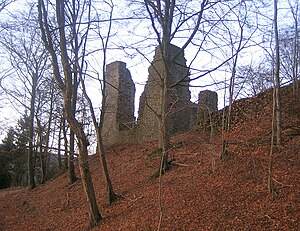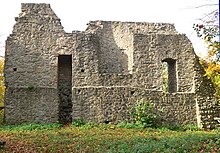Castle ruin Schönstein
| Castle ruin Schönstein | ||
|---|---|---|
|
Remains of the main building |
||
| Alternative name (s): | Schonenstein, Schonstein, Schoinstein | |
| Creation time : | 1331, first mentioned in 1350 | |
| Castle type : | Höhenburg, spur location | |
| Conservation status: | Remains of the wall in the main building | |
| Standing position : | Count | |
| Place: | Gilserberg - Schönau | |
| Geographical location | 50 ° 58 '49 .8 " N , 9 ° 3' 45.8" E | |
| Height: | 360 m above sea level NHN | |
|
|
||
The castle ruin Schönstein is the ruin of a Romanesque spur castle in the district of Schönau , a district of the community Gilserberg in the north Hessian Schwalm-Eder-Kreis ( Germany ).
Geographical location
The castle ruins are located in the Kellerwald-Edersee nature park on the western spur of the 419 m above sea level. NHN high Schloßberg , which is part of the western roofing of the Hemberg ridge . To the west, the mountain slope drops steeply into the Gilsa valley . The village of Schönstein, named after the castle, is 1.4 km to the north and the village of Schönau , both districts of Gilserberg, is located 1.1 km (as the crow flies ) to the southeast .
history
The history of the castle is only vaguely known: it was not until the 19th century that Felix von Gilsa zu Gilsa reported the history of the castle. Although it was first mentioned in a document in 1350, the castle was probably built by the Counts of Ziegenhain in the 12th century . It was used to control the road through the Gilsa valley.
God Bring von Linsingen is mentioned as Ziegenhainer Burgmann as early as 1170/1177 ; his family built Jesberg Castle . Because of its strategic location, Schönstein Castle, along with the Jesberg and Densberg castles , played an important strategic role in the Hessian - Mainz battles of the 13th and 14th centuries.
In 1300 Count Gottfried VI. von Ziegenhain gave the castle to Hermann von Löwenstein-Schweinsberg as a fief. Count Johann I , the son of Gottfried VI, established a new office there in 1350 . The villages of Lischeid , Moischeid , Winterscheid and Gerwigshain (today Wüstung), which had just been acquired by the Haina Monastery , as well as the places Falkenhain , Frankenhain , Treisbach (near Sebbeterode ), Schönau and Sachsenhausen that had previously belonged to the court on the Wasen (goat grove ) belonged to the office of Schönstein . In 1358 Johann I expanded the castle complex. In the period that followed, Schönstein Castle and Office were pledged again and again, as early as 1368 to Gottfried von Linsingen and the brothers Hans and Helwig von Gilsa zu Roppershausen , who also received permission to expand and strengthen the castle.
During the Star Wars the castle was conquered and destroyed by Landgrave Heinrich II of Hesse after a long siege in 1371 or 1372 . After being rebuilt, it was conquered again by Hessian troops in 1399 and then destroyed. It was rebuilt again, but now without a keep . In 1406 the Counts Gottfried IX pledged it . and Johann II von Ziegenhain a third of the castle and the office of Schönstein to Ekkebrecht von Grifte ; this pledge was redeemed in 1420 by the counts of Ziegenhain for 160 guilders, as his widow Elisabeth Schenck von Schweinsberg stated.
Through the inheritance contract of the last Count of Ziegenhain, Johann II , the castle and the entire county of Ziegenhain fell to the Landgraves of Hesse in 1450. In the Hessian fratricidal war in 1469, the Bohemian mercenaries of Landgrave Ludwig II of Hessen-Kassel destroyed the castle, which at that time belonged to his younger brother, Landgrave Heinrich III. von Hessen-Marburg , belonged. (The neighboring castles of Densberg and Jesberg suffered the same fate.)
Until 1543, the castle was still the seat of Hessian officials who administered the northern part of the former county of Ziegenhain, the Schönstein office with 14 places in the Gilserberg highlands. Otto Hund was the last bailiff in Schönstein. Until the castle was destroyed, the court days were held on the Schönstein.
From 1557 the castle gradually fell into disrepair. In 1601, residents of Schönau assured Landgrave Moritz the scholar that stones from the ruined castle had been used to build the Ziegenhain fortress and not to build their own houses.
Building description and current condition
The remains of the castle lie on a rectangular plateau with a base area of 20 by 36 meters. It was separated from the sloping slope by a deep ditch . To the southwest, moats were used for security. The main building ( Palas ) was three stories high, 20 m long and 9 m wide. There was also a keep that was destroyed twice in conquests and not rebuilt after the destruction in 1399. The best preserved today are the walls, which probably belonged to the hall with its windows and the fireplace. Locally occurring greywacke was used as the stone material for the buildings .
In 1987/1988 the remains of the castle were secured by the Schwalmstadt Forestry Office and the Hessian State Office for Monument Preservation .
Today the castle ruins are a popular destination, especially for hikers. The Kellerwaldsteig leads past the ruins.
literature
- Eduard Brauns: Hiking and travel guide through North Hesse and Waldeck. A. Benecker Verlag, Melsungen 1971, p. 198.
- Karl E. Demandt: History of the State of Hesse. Johannes Stauda Verlag, Kassel 1980, p. 206.
- Rudolf Knappe: Medieval castles in Hessen. 800 castles, castle ruins and fortifications. 3. Edition. Wartberg-Verlag, Gudensberg-Gleichen 2000, ISBN 3-86134-228-6 , p. 163 ff.
- Carl Heßler (Hrsg.): Hessische Landes- und Volkskunde: The former Kurhessen and the hinterland at the end of the 19th century. Volume 1: Hessian regional studies , second half. Elwert, Marburg 1907, p. 365.
Web links
- Entry from Jens Friedhoff to Schönstein b. Gilserberg in the scientific database " EBIDAT " of the European Castle Institute
- "Schönstein Castle, Schwalm-Eder District". Historical local dictionary for Hessen. In: Landesgeschichtliches Informationssystem Hessen (LAGIS).
- Schönstein Castle , on burgenwelt.de
- The lonely in the forest , description of the castle ruins, from August 17, 2014, on hna.de.
Individual evidence
- ↑ Map services of the Federal Agency for Nature Conservation ( information )
- ↑ "Ziegenhain, Schwalm-Eder District". Historical local dictionary for Hessen. In: Landesgeschichtliches Informationssystem Hessen (LAGIS).
- ^ Felix von Gilsa zu Gilsa: On the history of Schönstein Castle. In: Communications to the members of the Association for Hessian History and Regional Studies , born in 1885, I.-IV. Quarterly Bulletin, pp. CXXVI-CXXVII




